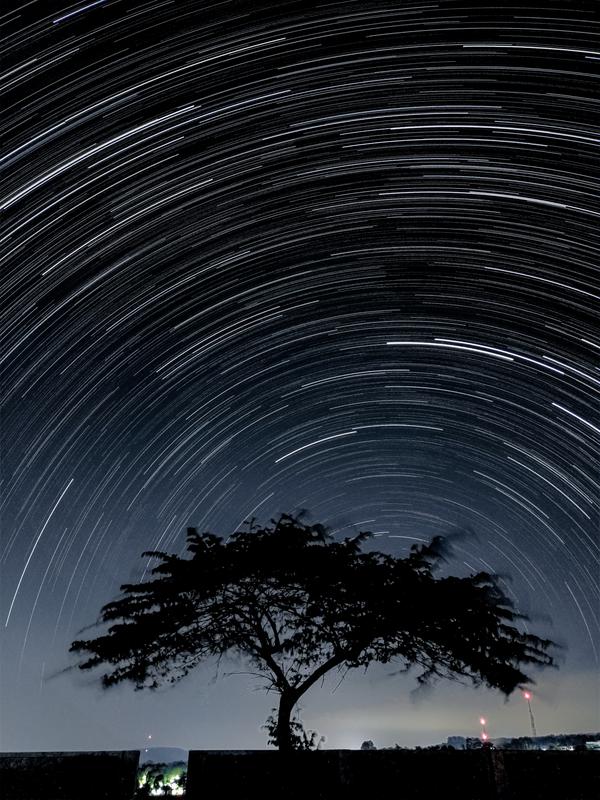This page describes an image Star Trail in the Southern Hemisphere with Bortle 4 Scale Light Pollution
Caption: This breathtaking photo, captured under the clear night sky of Linggamekar Village, Cilimus, Kuningan, West Java, Indonesia on 25 June 2020, displays star trails sweeping across the southern hemisphere’s heavens. The star trails are due to Earth’s rotation causing the apparent motion of stars, creating these mesmerising arcs of light when followed over extended periods. Here, the point the stars rotate around (the South Celestial Pole) is close to the horizon, as the image was taken close to the equator. The photographer used the star trail feature on a smartphone, which captured a series of images over an extended period and stacked them together. The striking tree in the foreground adds depth to the image, contrasting the celestial motion above with its Earthly stillness, while also masking some of the surrounding light pollution. Different parts of the world offer diverse and stunning perspectives on the night sky, emphasising the importance of preserving dark skies everywhere.
Captions in other languagesCredit:
Slamat Riyadi/IAU OAE (CC BY 4.0)
DOI: 10.5281/zenodo.10356977
Tags:
astrophotography
Related glossary terms:
Celestial Pole
, Celestial Sphere
, Earth's Rotation
Categories:
Naked Eye Astronomy
License: Creative Commons Attribution 4.0 International (CC BY 4.0) Creative Commons Attribution 4.0 International (CC BY 4.0) icons
The media file captions presented on the OAE website were written, translated and reviewed by a collective effort from the OAE, the OAE Centers and Nodes, the OAE National Astronomy Education Coordinators (NAECs) and other volunteers. You can find a full list of credits for our translation project here. All media file captions are released under a Creative Commons CC BY-4.0 license and should be credited to "IAU OAE". The media files themselves may have different licenses (see above) and should be credited as listed above under "credit".
Captions in Different Languages:
Caption: Gagnant du concours d'astrophotographie 2023 de l'UAI OAE, catégorie Images fixes avec smartphones-appareils mobiles : Traînée d'étoiles dans l'hémisphère sud avec pollution lumineuse à un niveau 4 sur l'échelle de Bortle, par Slamat Riyadi.
Cette photo, à couper le souffle, prise sous le ciel nocturne clair du village de Linggamekar, Cilimus, Kuningan, Java occidental, Indonésie, le 25 juin 2020, montre des traînées d'étoiles balayant les cieux de l'hémisphère sud. Elle est l'une des six lauréates dans la catégorie des images fixes prises exclusivement avec des smartphones/appareils mobiles. Les traînées d'étoiles sont dues à la rotation de la Terre qui provoque le mouvement apparent des étoiles, créant ces arcs de lumière envoûtants lorsqu'ils sont suivis sur de longues périodes. Ici, le point autour duquel tournent les étoiles (le pôle céleste sud) est proche de l'horizon, car l'image a été prise près de l'équateur. Le photographe a utilisé la fonction de suivi des étoiles d'un smartphone, qui a capturé une série d'images sur une période prolongée et les a empilées. L'arbre remarquable au premier plan ajoute de la profondeur à l'image, contrastant avec le mouvement céleste et l'immobilité terrestre, tout en masquant une partie de la pollution lumineuse environnante. Les différentes régions du monde offrent des perspectives variées et étonnantes sur le ciel nocturne, soulignant l'importance de préserver le ciel noir partout dans le monde.
Credit: Slamat Riyadi/UAI OAE (CC BY 4.0)
Related glossary terms: Celestial Pole , La rotation de la Terre , Sphère Céleste Caption translation status: Not yet approved by a reviewer
Caption translators: Gilles Remy
Caption: Vincitore del concorso di astrofotografia IAU OAE 2023, categoria Immagini fisse con smartphone-dispositivi mobili: Percorso stellare nell'emisfero australe con inquinamento luminoso in scala Bortle 4, di Slamat Riyadi.
Questa foto mozzafiato, scattata il 25 giugno 2020 sotto il cielo limpido di Linggamekar Village, Cilimus, Kuningan, Giava Occidentale, Indonesia, mostra le scie stellari che attraversano i cieli dell'emisfero meridionale. È una delle sei vincitrici nella categoria Immagini fisse scattate esclusivamente con smartphone/dispositivi mobili. Le scie stellari sono dovute alla rotazione terrestre che provoca il movimento apparente delle stelle, che, se seguite per lungi periodi, creano questi archi di luce ipnotici. In questo caso, il punto attorno al quale ruotano le stelle (il Polo Sud Celeste) è vicino all'orizzonte, poiché l'immagine è stata scattata in prossimità dell'equatore. Il fotografo ha utilizzato la funzione star trail di uno smartphone, che ha catturato una serie di immagini per un periodo prolungato e le ha impilate insieme. Il suggestivo albero in primo piano aggiunge profondità all'immagine, contrastando il movimento celeste in alto con l'immobilità terrestre e mascherando anche parte dell'inquinamento luminoso circostante. Le diverse parti del mondo offrono prospettive diverse e sorprendenti sul cielo notturno, sottolineando l'importanza di preservare i cieli bui ovunque.
Credit: Slamat Riyadi/IAU OAE (CC BY 4.0)
Related glossary terms: Polo Celeste , Rotazione della Terra , Sfera celeste Caption translation status: Not yet approved by a reviewer
Caption translators: Valentina La Parola
Caption: 这张令人叹为观止的照片是 2020 年 6 月 25 日在印度尼西亚西爪哇库宁安省西里穆斯市凌加梅卡村的晴朗夜空下拍摄的,照片中的星轨掠过南半球的天际。星轨是地球自转所导致的恒星表观运动,当长时间跟踪时,就会产生这些令人着迷的光弧。因为这张照片是在赤道附近拍摄的,所以恒星所围绕旋转的点(南天极)靠近地平线。摄影师使用智能手机上的星轨功能,在较长时间内拍摄了一系列图像,并将它们叠加在一起。前景引人注目的大树增添了画面的深度,使上方天体的运动与地面的静止形成了鲜明对比,同时也遮掩了周围的一些光污染。世界不同地区的夜空景色各异,令人惊叹,使人们意识到保护各地黑暗天空的重要性。
Credit: Slamat Riyadi/IAU OAE (CC BY 4.0)
Related glossary terms: Celestial Pole , Celestial Sphere , Earth's Rotation Caption translation status: Not yet approved by a reviewer
Caption translators: Bao Lizhuo
Caption: 這張令人歎為觀止的照片是 2020 年 6 月 25 日在印度尼西亞西爪哇庫寧安省西里穆斯市凌加梅卡村的晴朗夜空下拍攝的,照片中的星軌掠過南半球的天際。星軌是地球自轉所導致的恆星表觀運動,當長時間跟蹤時,就會產生這些令人著迷的光弧。因為這張照片是在赤道附近拍攝的,所以恆星所圍繞旋轉的點(南天極)靠近地平線。攝影師使用智能手機上的星軌功能,在較長時間內拍攝了一系列圖像,並將它們疊加在一起。前景引人注目的大樹增添了畫面的深度,使上方天體的運動與地面的靜止形成了鮮明對比,同時也遮掩了周圍的一些光汙染。世界不同地區的夜空景色各異,令人驚嘆,使人們意識到保護各地黑暗天空的重要性。
Credit: Slamat Riyadi/IAU OAE (CC BY 4.0)
Related glossary terms: Celestial Pole , Celestial Sphere , Earth's Rotation Caption translation status: Not yet approved by a reviewer
Caption translators: An automated transliteration from the simplified Chinese translation by - Bao Lizhuo









